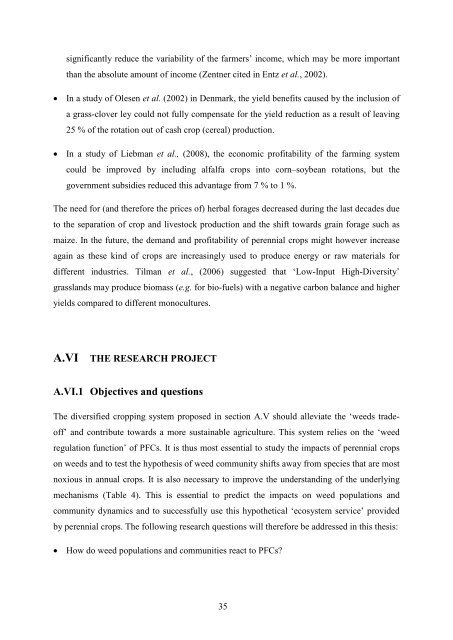Diversifying crop rotations with temporary grasslands - Université de ...
Diversifying crop rotations with temporary grasslands - Université de ...
Diversifying crop rotations with temporary grasslands - Université de ...
You also want an ePaper? Increase the reach of your titles
YUMPU automatically turns print PDFs into web optimized ePapers that Google loves.
significantly reduce the variability of the farmers’ income, which may be more important<br />
than the absolute amount of income (Zentner cited in Entz et al., 2002).<br />
• In a study of Olesen et al. (2002) in Denmark, the yield benefits caused by the inclusion of<br />
a grass-clover ley could not fully compensate for the yield reduction as a result of leaving<br />
25 % of the rotation out of cash <strong>crop</strong> (cereal) production.<br />
• In a study of Liebman et al., (2008), the economic profitability of the farming system<br />
could be improved by including alfalfa <strong>crop</strong>s into corn–soybean <strong>rotations</strong>, but the<br />
government subsidies reduced this advantage from 7 % to 1 %.<br />
The need for (and therefore the prices of) herbal forages <strong>de</strong>creased during the last <strong>de</strong>ca<strong>de</strong>s due<br />
to the separation of <strong>crop</strong> and livestock production and the shift towards grain forage such as<br />
maize. In the future, the <strong>de</strong>mand and profitability of perennial <strong>crop</strong>s might however increase<br />
again as these kind of <strong>crop</strong>s are increasingly used to produce energy or raw materials for<br />
different industries. Tilman et al., (2006) suggested that ‘Low-Input High-Diversity’<br />
<strong>grasslands</strong> may produce biomass (e.g. for bio-fuels) <strong>with</strong> a negative carbon balance and higher<br />
yields compared to different monocultures.<br />
A.VI THE RESEARCH PROJECT<br />
A.VI.1 Objectives and questions<br />
The diversified <strong>crop</strong>ping system proposed in section A.V should alleviate the ‘weeds tra<strong>de</strong>off’<br />
and contribute towards a more sustainable agriculture. This system relies on the ‘weed<br />
regulation function’ of PFCs. It is thus most essential to study the impacts of perennial <strong>crop</strong>s<br />
on weeds and to test the hypothesis of weed community shifts away from species that are most<br />
noxious in annual <strong>crop</strong>s. It is also necessary to improve the un<strong>de</strong>rstanding of the un<strong>de</strong>rlying<br />
mechanisms (Table 4). This is essential to predict the impacts on weed populations and<br />
community dynamics and to successfully use this hypothetical ‘ecosystem service’ provi<strong>de</strong>d<br />
by perennial <strong>crop</strong>s. The following research questions will therefore be addressed in this thesis:<br />
• How do weed populations and communities react to PFCs?<br />
35

















